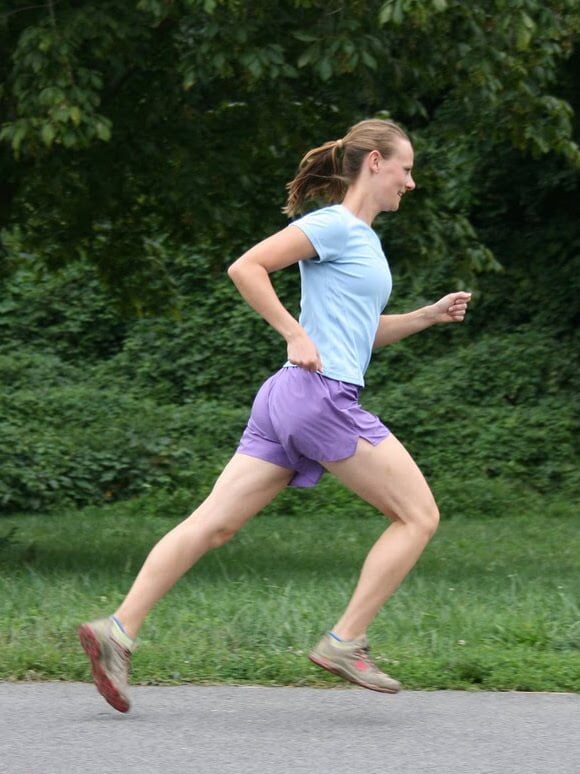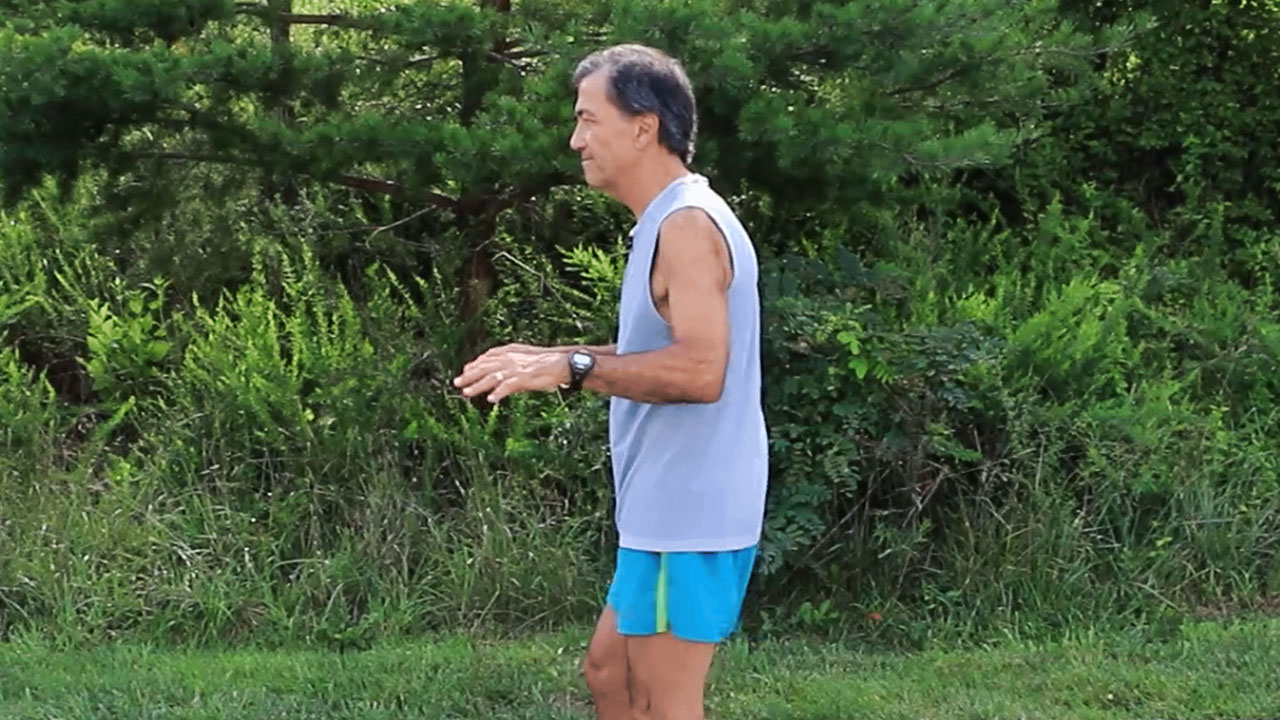We’d like to let you in on our secret: How to add power to your ChiRunning without increasing the workload to your legs. Sound crazy? Or, impossible?
Our goal at ChiRunning is to convince you to run as relaxed as possible, especially if you want to go faster. Our whole intent is to show you how to fall forward, into the pull of gravity, for your propulsion while at the same time relaxing your lower body, allowing the oncoming road to swing your legs for you. The sole purpose of doing these two things in your ChiRunning (falling and relaxing) is to redirect most of the workload away from your legs so that adding speed or distance to your running doesn’t cost you by increasing impact to your joints or overuse to your muscles.
One of the guiding principles of ChiRunning is mindfulness-based movement, where you’re constantly working to improve your ability to sense your body, engage your mind and progress in your skill level. With that in mind, Active Pelvic Rotation is a more advanced skill to gain easy speed as the next step in your ChiRunning. It happens when you exert and direct some of the Chi you’ve been cultivating.
“Yesterday, I did a long trail run that is about 1000′ of climb and shaved off about 20 minutes! Pelvic rotation on the uphills with improved arm swing made all the difference! I was flying in 3rd gear on the downhills with such ease that I was just laughing with joy! And, no soreness or knee pain today.” – Cheryl, Reno, NV
Falling forward is easier than pushing or pulling yourself forward. But allowing your legs to relax as you run can, for some, be a bit more challenging. That’s why we teach Passive Pelvic Rotation in all of our classes.
Pelvic rotation has two modes: Passive Pelvic Rotation and Active Pelvic Rotation.
Here’s what they are and how they differ:
Passive Pelvic Rotation
In ChiRunning, you allow yourself to gently fall forward which allows gravity to pull you. Consequently, you are left with only having to pick up your feet to keep up with your forward motion. This significantly reduces the work done by your legs because, as you fall forward, you allow your lower body to relax, allowing your legs to be swung rearward by the oncoming road. When your legs swing rearward as they hit the ground, impact to your knees, hips and lower back can become a thing of the past.
The following illustration shows how conventional running (top) compares to ChiRunning (bottom).

Conventional Running

ChiRunning Pelvic Rotation
With conventional running your pelvis always faces forward and your legs swing from your hips. With ChiRunning, as you fall forward, your legs and pelvis swing together and your stride length increases in the rearward direction because, as your leg swings rearward, it pulls your hip with it, creating a rotation in your pelvis. This gives you a longer rearward stride without adding stress to the hip joint. And, as you might have guessed, a longer rearward stride (as the Kenyans have so beautifully demonstrated) equals faster speed.
This is in stark contrast to conventional running which requires you to push yourself forward with every stride, which leads to chronic overstriding and is much less economical, especially if you’re running distances beyond a 5K. The muscle effort required to push you forward is what makes the typical runner more tired than they really need to be. It is much easier to pick up your feet than to push yourself forward when running.

“It was my best race so far. I felt strong, and there were many times when everything just came together – pelvic rotation, legs swinging to the rear, relaxed feet and legs, circular feet… I would feel like I was flowing over the ground practically without effort! I had a strong finishing kick at the end, and my overall per-mile pace was over 30 seconds faster than the Flat Half on Sauvie Island that I did in July. I felt pumped and energetic afterward, and had no soreness, and still none today!” – Mary, Portland, OR
Benefits of Passive Pelvic Rotation:
- Adds smoothness to your stride (think Kenyans) by preventing over-striding (braking)
- Reduces impact, especially on downhills by emphasizing a rearward stride
- Creates a more unified system of body movement by coordinating your upper body with your lower body
- Protects your hamstrings from overuse by eliminating over-striding and “pulling”
- Easy to learn, and it’s a total game-changer when you change your mindset from power to relaxation
Active Pelvic Rotation
 This is an advanced version of Passive Pelvic Rotation that can be used for running faster or for running up hills. I call it “advanced” because, in order to do it, you must first have integrated Passive Pelvic Rotation into your repertoire of ChiRunning skills. In other words, once Passive Pelvic Rotation has become your norm, you can then add in some power from your core without upping the workload to your legs.
This is an advanced version of Passive Pelvic Rotation that can be used for running faster or for running up hills. I call it “advanced” because, in order to do it, you must first have integrated Passive Pelvic Rotation into your repertoire of ChiRunning skills. In other words, once Passive Pelvic Rotation has become your norm, you can then add in some power from your core without upping the workload to your legs.
With Active Pelvic Rotation, you’ll gain “easy speed” by engaging your arms and your obliques, driven by your breath, which ups your amperage without blowing a fuse. An exaggerated arm swing, with an emphasis both forward and rearward, drives your hips rearward by engaging your obliques, which in turn drives your legs.
With ChiRunning, natural degradation of how you move as you age can be averted to a safe, sustainable, and intentional way of going faster or farther without taking it out on your body. Engaging your stronger core muscles (in this case primarily obliques) to drive your hips and legs, keeps the smaller, more vulnerable muscles of your legs from overworking.
Benefits of Active Pelvic Rotation:

- Transfers your power source away from your legs by engaging your obliques and arm swing
- Increases efficiency by using a larger, stronger group of muscles to replace a smaller muscle group… with the same, or better, results
- Allows you to rely on two muscle groups (arms and obliques) few distance runners ever use
- Adds power to your stride without relying on the strength of your legs
Whether you’re a new, or slower runner, or love to run fast, the source and impetus for your movement come from the same place when you practice ChiRunning– your pelvis.
To learn more about Passive and Active Pelvic Rotation, find a Certified ChiRunning instructor near you, or check out the ChiRunning School videos and lessons to see how it’s done.
We are so used to using strength, force, and exertion in our lives, and especially in our fitness programs, we’ve lost sight of our innate ability to move, and especially to run, easily in a relaxed but powerful way.

